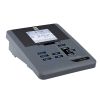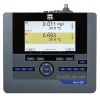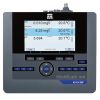YSI TruLine Potassium Electrode
Features
- PVC membrane with replaceable module
- Double junction reference
- 0.04-39,000 mg/L range
- Free ground shipping
- Expedited repair and warranty service
- Lifetime technical support
- More
Overview
The YSI TruLine combination potassium electrode measures potassium and can be used with the YSI TruLab 1320. It can also be used with the YSI MultiLab 4010-2 or 4010-3 if a BNC adapter is installed.
TruLine Series
The TruLine series of laboratory ISEs consists of 15 electrodes that have an integrated reference, eliminating the need to have a separate reference half-cell. Each TruLine ISE has a refillable double-junction reference, resulting in a long electrode life and exceptional measurement reliability. TruLine ISEs can be connected to any ISE instrument featuring BNC connection, including the YSI 1320. Reference/electrode fill solution, ionic strength adjustor, and a small bottle of standard are included with each ISE.
Benefits
- Wide selection of 15 electrodes for 16 different parameters
- 4 sensor technologies - gas sensing, polymer/PVC membrane, solid state, and glass sensor
- Combination (i.e. full-cell), refillable electrodes with double-junction reference
- BNC connection, 1m cable
- Made in the U.S.A
- Reference/electrode fill solution, ionic strength adjustor, and a small bottle of standard included with each ISE
- 12-month warranty for solid state, glass sensor, and gas-sensing ISEs
- 9-month warranty for ISEs with polymer/PVC membrane
- (1) Electrode with 1m cable
- (1) Small bottle of reference/electrode fill solution
- (1) Small bottle of ionic strength adjuster
- (1) Small bottle of standard solution
In The News
From Hurricanes to Florida’s Red Tides: Monitoring the Southwest Gulf Coast
Nearly every year, southwest Florida is blighted by harmful Karenia brevis blooms–known colloquially as Florida red tides. These harmful algal blooms (HABs) form over the West Florida shelf and are pushed shorewards by winds and currents. Once in touching distance of the coast, they often intensify, fed by land-based runoff, anthropogenic nutrients, and decomposing marine life killed by toxins produced by these red tides. Red tides have become more severe and persistent over the past 20 years, causing major environmental and economic damage.
Read MoreWave-Powered Buoy Deployed in Puget Sound
While the development of solar-powered monitoring systems has improved access to real-time environmental data, solar power is still limited by low light conditions, such as poor weather, nighttime, or high-latitude environments. To supplement these incumbent power solutions at sea, Ocean Motion Technologies has developed a small-scale ocean wave energy system that can be directly integrated with existing data buoy platforms. Not only does wave energy supplement solar power during periods when the buoys are limited by light availability, but it also allows data buoys to perform beyond their current power capacities.
Read MoreLong-Term Monitoring in the Chautauqua Lake Watershed
With a widely developed shoreline, Chautauqua Lake experiences influxes of non-point source pollution that have historically impacted the health of the lake. The Chautauqua Lake Association (CLA) has been monitoring the lake for over two decades, reporting on changes that have occurred over the years. A pair of local lake advocates, Jane and Doug Conroe, have lived on the lake for over 40 years and have played an important role in establishing monitoring programs and facilitating consistent data collection throughout the watershed. Doug has been involved with the Chautauqua Lake Association (CLA) since the pair moved to the area in 1980, and is currently serving as the Executive Director.
Read More














